Today we take a look at the $499 USD Etymotic EVO In-Ear Monitors.
Disclaimer: Etymotic sent us the EVO In-Ear Monitors for the purposes of this review, free of charge. I only covered the import taxes and fees. All thoughts and experiences with the product are naturally my own. Headfonia and Etymotic are not related in any way.
Etymotic Company
Who doesn’t know Etymotic? Etymotic Research is an engineering-driven research, development, and manufacturing company. The name “Etymotic” (pronounced “et-im-oh-tik.”) means “true to the ear.” Mead Killion, Ph.D. founded Etymotic Research in 1983 to design products that accurately assess hearing, improve the lives of those with hearing loss, protect hearing, and enhance the listening experience of musicians and music lovers everywhere.
With deep roots in acoustic research and the hearing aid industry, Etymotic invented insert earphones in 1984. Etymotic’s original earphone design used balanced armature receivers, which established these speakers as the gold standard for high definition in-ear earphones. The first versions were used for diagnostic testing and precision auditory research (ER-1, 2, 3). Etymotic produced the first noise-isolating high-fidelity in-ear earphone, the ER-4 (1991), which became the basis of all subsequent in-ear earphones and in-ear monitors worldwide, and created an entire category of consumer electronics.
Now, we have the EVO. Evo is the first earphone from Etymotic that features a multi-driver layout, a stainless steel shell, and a concha-locked fit. The EVO utilizes 3 drivers per side and as with all Etymotic earphones, it focuses on tonal accuracy. Etymotic has an excellent track record from my experience and thus, I am quite excited for this review.
You can find all of our Etymotic reviews here: https://www.headfonia.com/?s=Etymotic
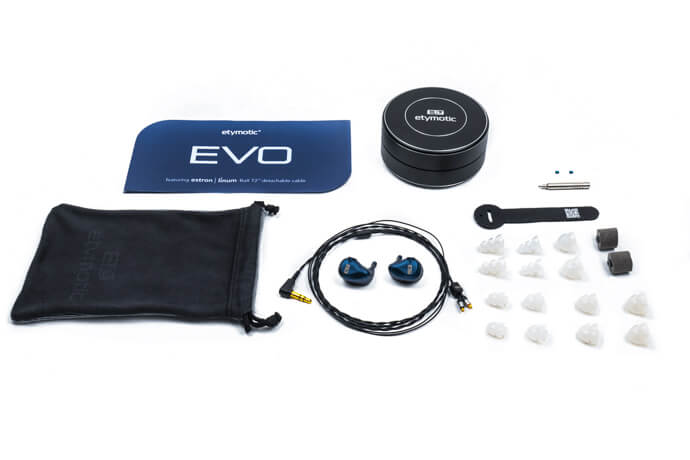
Accessories
The unit I received came without the packaging so I will not be talking about that, instead, we are going to take a look at the accessories.
The Evo’s accessory package is rich, you have everything you need while using the earphones. Etymotic provides 7 pairs of silicone tips and 1 pair of foam tips. You also get a circular, lightweight aluminum carrying case and a smooth-textured carrying pouch for all your transportation needs. I liked the quality of both of them. Note that the circular case is not very heavy. That is nice because I don’t really like hefty cases, I tend to leave those at home and they are no use to me while carrying my gear.
Apart from those, you get a filter-change tool, which is my favorite accessory out of all the others. Etymotic has included two replacement filters in the package and you can also experiment with different filters as they are compatible with the EVO. Overall, I found the quality of the accessories to be good and the tips are quite sufficient in terms of quantity. I will talk about the EVO’s special cable in the next chapter.
Linum G2 BaX Cable
Linum cables are designed and manufactured by Estron a/s. They have been in the industry for a long time and I have used Estron’s Linum Music, and Linum BaX cables before. My experience has been quite good with both of them. They have an excellent build quality and they feature really low microphonics. They have quite a resistant jacket as well. After 3 years of extensive use, they were still in mint condition and I am really happy that the Etymotic EVO comes bundled with the new G2 BaX in a black sleeve. The Linum cables have a lot of features such as high tensile strength, a really lightweight build, and a tangle-resistant UV stabilized TPA jacket.
As for the wires, the cable utilizes a double-twisted design with 84 strands of silver-plated copper litz wire. It is very thin and flexible. If you are wearing glasses like I do, I need to tell you that this is the best cable when it comes to ergonomics. You don’t even feel it at all. It is so lightweight that it is only 5 grams in total. The bundled cable features T2 connectors and they are very good in terms of durability and they do not loosen over time like 2-Pin cables. I’ve had my fair share of MMCX connector oxidation issues but I have never experienced anything like that with the T2 connector. I am very glad that the Etymotic chose this route to offer us a more premium experience.
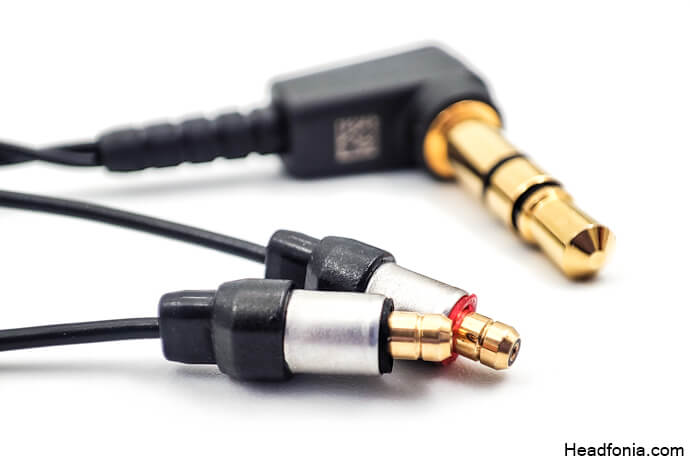
Design & Fit
Right off the bat, I am very happy that Etymotic has gone beyond the limits of their classical design boundaries. They have been quite meticulous with all of their designs, therefore I had high hopes about the EVO from the start. It is safe to say that Etymotic did not disappoint me at all, they even impressed me with their new stainless steel metal injection molded housing finished with a beautiful shade of metallic blue. The shell looks very durable and rigid. It is also not very lightweight at around 25 grams in total. I especially liked the metallic blue finish, it looks anodized and shines bright like a diamond under a light source.
The 2-piece shell has a T2 connector socket on top and a very long, Etymotic-style nozzle. Etymotic states that their engineers have studied the shape of the ear and looked for the most comfortable fit for the majority of people. I can say that the fit is excellent and their R&D work seems to have been successful. The earphone sits snugly in my ear’s concha, without any discomfort and irritation. After so many tubular-design shells, it makes me very happy to see that the Etymotic now has a killer housing that has plenty of internal space. It is also equally pleasing to see that they retained the interchangeable filter system with their new housing. Additionally, thanks to the excellent comfort and seal, the passive isolation is brilliant.
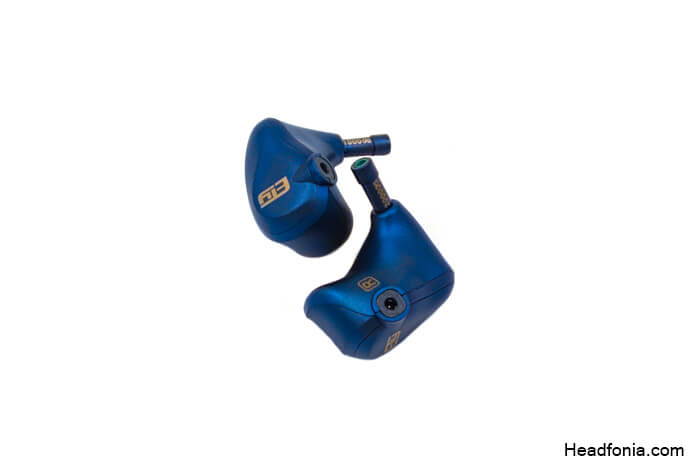
Specifications & Technical Data
Frequency Response: 20 Hz – 16 kHz
Transducers: 3 BA
Crossover: 2-Way
Impedance: 47 ohms
Sensitivity: 1khz – 99 dB SPL at 0.1V
Looking at these specs we can see that the EVOs with 47 Ohm impedance and 99 dB sensitivity does not seem so hard to drive. So on paper you don’t need a whole lot of power to feed them. However, I will be using my SMSL SU-8s & SMSL SH-8s desktop rig as the testing bench.
The review continues on Page Two, after the click HERE or by using the jump below.
Page 2: Sound Signature, Low, Mid, High, Technical Performance, Comparisons, Last Words






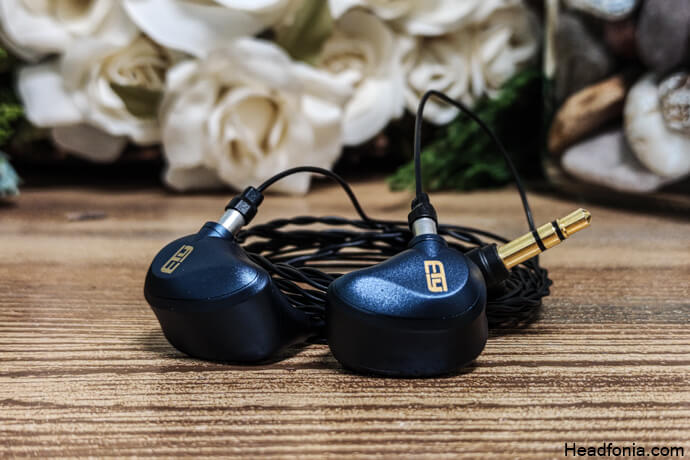
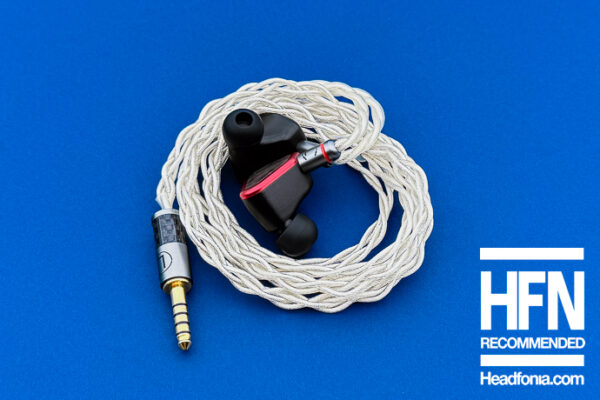
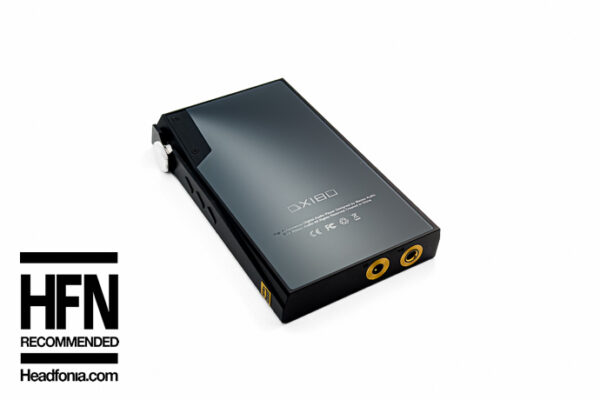
Graham
Thank you for the review. As a lover of the ER4 XR, I am very excited about this new headphone; can’t wait to audition and compare to the ER4 directly…
Yagiz
Thanks Graham. You should give it a try, it still is an Etymotic but on steroids!
BT
Great review! The “classic” Etymotic IEM shape (i.e. ultra-deep insertion) never suited my ear canals, so I’m stoked to try this one out
Yagiz
Thanks BT.
I don’t like the triple-flange fit, too. It is a little too intrusive 🙂
Patrick G Murray
I am actually in the market for an IEM, I have a earsonics sm64, had but sold an audiofly af1120(which was their flagship and it was definitely a great IEM), as well as a Nuforce primo 8. Unfortunately the SM64 is damaged and has me looking elsewhere for an IEM. I interested in this because it seems balanced and neutral without perhaps being too flat and being labeled as perhaps boring. Thanks for this review it was insightful and put this on the map for me.
James Reinhart
Has anyone performed a test with analog sources? My classical and jazz records from the 60s and 70s when playing them on my system (Maggie 3.6R, Marantz 11 reference, Micro Ruby H, power regenerator are all early pressings that have infinitely more musical sound as the nuances have not been reproduce even in SHM SACD, digital oversampling devices of any kind and vinyl produced decades later. I also have very low number Mobile Fidelity Records many less than 20. It has been apparent to anyone that switching from digital of any form to the analog is no contest.